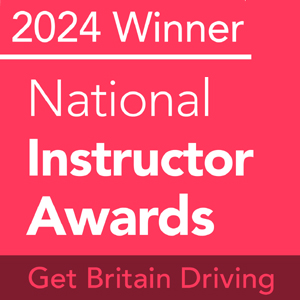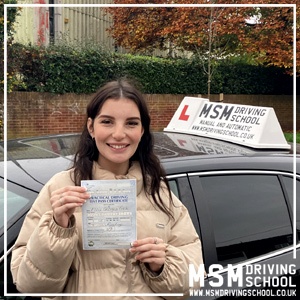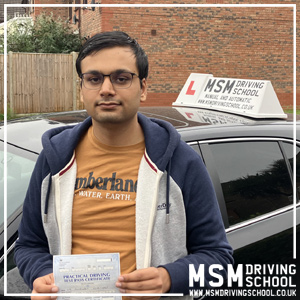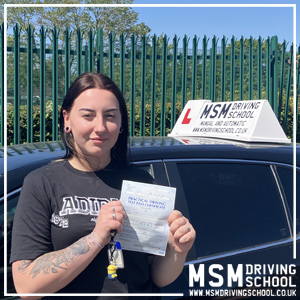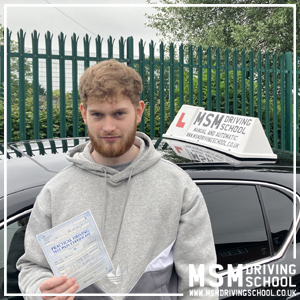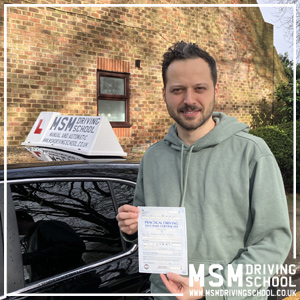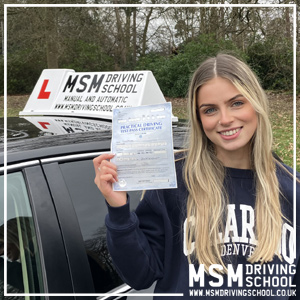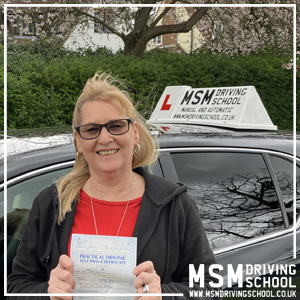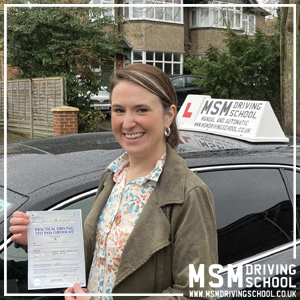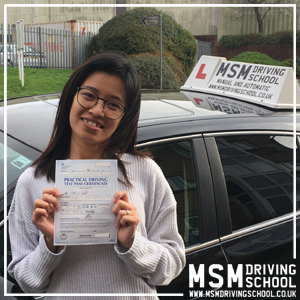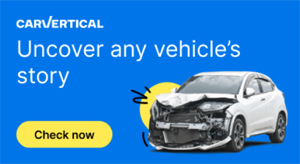What To Expect On Your Driving Test
On the 4th of December 2017, the UK practical driving test changed. There were 4 main changes from the old practical driving test. The changes were as follows...
1. The independent driving part of the test was increased to 20 minutes.
The independent driving part of the test used to last around 10 minutes. During this part of the test, you would have to drive without turn-by-turn directions from the driving examiner (e.g. following road signs). This part of the test is now longer, so it’ll last around 20 minutes (this is roughly half of the test).
2. Following directions from a sat nav.
During the independent driving part of the test, you may be asked to follow directions from a sat nav. The examiner will provide the sat nav (currently a TomTom Start 52). Don't worry, you won’t need to set the route, the examiner will do this for you. Please Note: It doesn’t matter what make or model of sat nav you practise with. You will be able to ask the examiner for confirmation of where you’re going if you’re not sure. If you do happen to go the wrong way, DON'T WORRY. It doesn’t matter if you go the wrong way unless you make a fault while doing it. Only one in 5 driving tests won’t use a sat nav. If this is the case, you will need to follow traffic signs instead.
3. Reversing manoeuvres have changed.
The ‘reverse around a corner’ and the ‘turn-in-the-road’ manoeuvres are now no longer tested, but you should still be taught them by your instructor.
Instead, you’ll be asked to do one of 3 possible reversing manoeuvres:
- Parallel park behind a car at the side of the road.
- Park in a parking bay, either by driving in and reversing out, or reversing in and driving out (the examiner will tell you which you have to do).
- Pull up on the right-hand side of the road, reverse for 2 car lengths and then rejoin the traffic.
4. Answering a vehicle safety question while you’re driving.
The examiner will ask you 2 vehicle safety questions during your driving test, these are known as the ‘show me, tell me’ questions.
You’ll be asked...
One ‘Tell Me’ question (where you explain how you’d carry out a safety task) at the start of your test, before you start driving
One ‘Show Me’ question (where you show how you’d carry out a safety task) while you’re driving - for example, showing how to wash the windscreen using the car controls and wipers
At the beginning of your driving test, the driving test examiner will want to inspect your valid UK provisional driving licence. If you fail to bring this with you on your test day, the driving test examiner WILL terminate your driving test before it even starts.
Next is the eyesight test. You will be asked by the driving test examiner to read a number plate at either 20 metres for vehicles with a new-style number plate or a distance of 20.5 meters with an old-style number plate. After this you will then go to your car (or your driving instructors car), you will then be asked 2 of the DVSA 'show me, tell me' questions (below).
If you are taking your driving test in a driving school car, you should ensure that you become familiar with all of the controls as you may be asked to identify them at the start of your driving test. Your driving instructor will teach you this during your driving lessons .
The 'Show Me, Tell Me' questions (listed below) are designed to check your knowledge of basic car safety and will include one 'show me' question, where you actually have to demonstrate how and what you would do to check / adjust something, and one 'tell me' question where you would simply have to explain how you would do something.
The driving part of your test will last for around 40 minutes. Throughout the test, your examiner will be looking for an overall safe standard of driving.
During your test the examiner will give you directions that you should follow. You will drive in various road and traffic conditions. You should drive in the way your instructor has trained you.
You will have to demonstrate how well you can safely reverse your vehicle.
Your driving test will include around 20 minutes of independent driving. It is designed to assess your ability to drive safely while making decisions on your own.
If you make mistake just carry on! If it is not a serious mistake it might not affect your result.
At the end of the test you will get a debreif from the examiner and hopefully you will hear... "Congratulations, I'm pleased to tell you..."
Book a practical driving test.
View the pratical driving test marking sheet.
Read what is assessed, what sorts of things count as faults, and how to improve in each area.
Read the guidance for driving examiners on assessment and marking of driving tests.
Read the national standard for driving cars and light vans.
If you have any questions about your driving test or need any advice on learning to drive, feel free to email us or drop us a message on WhatsApp and one of our experienced driving instructors will be happy to help.
DVSA "Show Me, Tell Me Questions" 2025.
"Show Me" Questions:
1. When it’s safe to do so, can you show me how you wash and clean the rear windscreen?
2. When it’s safe to do so, can you show me how you wash and clean the front windscreen?
3. When it’s safe to do so, can you show me how you’d switch on your dipped headlights?
4. When it’s safe to do so, can you show me how you’d set the rear demister?
5. When it’s safe to do so, can you show me how you’d operate the horn?
6. When it’s safe to do so, can you show me how you’d demist the front windscreen?
7. When it’s safe to do so, can you show me how you’d open and close the side window?
"Tell Me" Questions:
1. Tell me how you’d check that the brakes are working before starting a journey.
Brakes should not feel spongy or slack. Brakes should be tested as you set off. Vehicle should not pull to one side.
2. Tell me where you’d find the information for the recommended tyre pressures for this car and how tyre pressures should be checked.
Manufacturer’s guide, use a reliable pressure gauge, check and adjust pressures when tyres are cold, don’t forget spare tyre, remember to refit valve caps.
3. Tell me how you make sure your head restraint is correctly adjusted so it provides the best protection in the event of a crash.
The head restraint should be adjusted so the rigid part of the head restraint is at least as high as the eye or top of the ears, and as close to the back of the head as is comfortable. Note: Some restraints might not be adjustable.
4. Tell me how you’d check the tyres to ensure that they have sufficient tread depth and that their general condition is safe to use on the road.
No cuts and bulges, 1.6mm of tread depth across the central three-quarters of the breadth of the tyre, and around the entire outer circumference of the tyre.
5. Tell me how you’d check that the headlights and tail lights are working. You don’t need to exit the vehicle.
Explain you’d operate the switch (turn on ignition if necessary), then walk round vehicle (as this is a ‘tell me’ question, you don’t need to physically check the lights).
6. Tell me how you’d know if there was a problem with your anti-lock braking system.
Warning light should illuminate if there is a fault with the anti-lock braking system.
7. Tell me how you’d check the direction indicators are working. You don’t need to exit the vehicle.
Explain you’d operate the switch (turn on ignition if necessary), and then walk round vehicle (as this is a ‘tell me’ question, you don’t need to physically check the lights).
8. Tell me how you’d check the brake lights are working on this car.
Explain you’d operate the brake pedal, make use of reflections in windows or doors, or ask someone to help.
9. Tell me how you’d check the power-assisted steering is working before starting a journey.
If the steering becomes heavy, the system may not be working properly. Before starting a journey, 2 simple checks can be made.
Gentle pressure on the steering wheel, maintained while the engine is started, should result in a slight but noticeable movement as the system begins to operate. Alternatively turning the steering wheel just after moving off will give an immediate indication that the power assistance is functioning.
10. Tell me how you’d switch on the rear fog light(s) and explain when you’d use it/them. You don’t need to exit the vehicle.
Operate switch (turn on dipped headlights and ignition if necessary). Check warning light is on. Explain use (when the visibilty drops below 100 meters).
11. Tell me how you switch your headlight from dipped to main beam and explain how you’d know the main beam is on.
Operate switch (with ignition or engine on if necessary), check with main beam warning light.
12. Open the bonnet and tell me how you’d check that the engine has sufficient oil.
Identify dipstick/oil level indicator, describe check of oil level against the minimum and maximum markers.
13. Open the bonnet and tell me how you’d check that the engine has sufficient engine coolant.
Identify high and low level markings on header tank where fitted or radiator filler cap, and describe how to top up to correct level.
14. Open the bonnet and tell me how you’d check that you have a safe level of hydraulic brake fluid.
Identify reservoir, check level against high and low markings.
Please note: All of the above DVSA 'show me, tell me' questions are correct as of February 2025.
Driving Lessons in Reading with MSM Driving School - Driving tuition you can trust.








